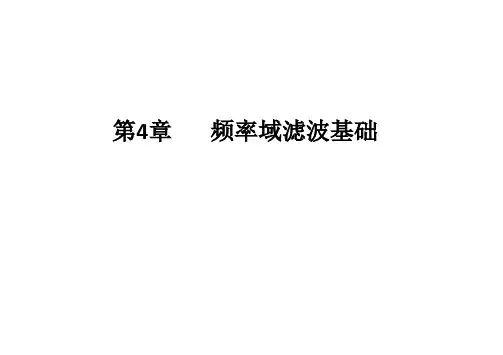数字图像处理课件(冈萨雷斯第三版)
- 格式:ppt
- 大小:2.99 MB
- 文档页数:133
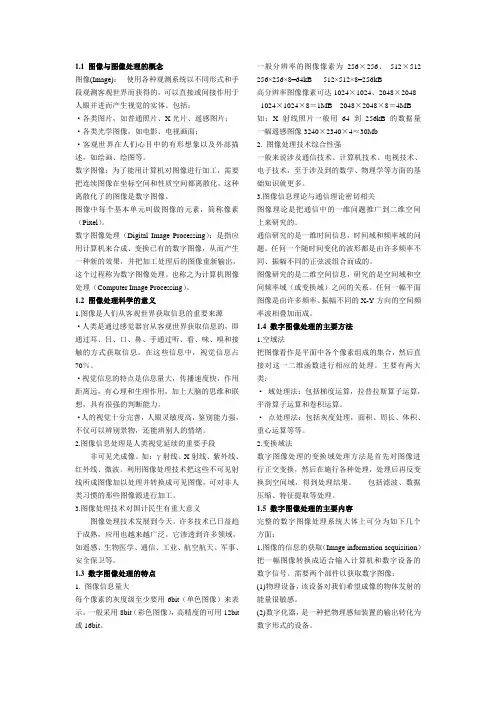
1.1 图像与图像处理的概念图像(Image):使用各种观测系统以不同形式和手段观测客观世界而获得的,可以直接或间接作用于人眼并进而产生视觉的实体。
包括:·各类图片,如普通照片、X光片、遥感图片;·各类光学图像,如电影、电视画面;·客观世界在人们心目中的有形想象以及外部描述,如绘画、绘图等。
数字图像:为了能用计算机对图像进行加工,需要把连续图像在坐标空间和性质空间都离散化,这种离散化了的图像是数字图像。
图像中每个基本单元叫做图像的元素,简称像素(Pixel)。
数字图像处理(Digital Image Processing):是指应用计算机来合成、变换已有的数字图像,从而产生一种新的效果,并把加工处理后的图像重新输出,这个过程称为数字图像处理。
也称之为计算机图像处理(Computer Image Processing)。
1.2 图像处理科学的意义1.图像是人们从客观世界获取信息的重要来源·人类是通过感觉器官从客观世界获取信息的,即通过耳、目、口、鼻、手通过听、看、味、嗅和接触的方式获取信息。
在这些信息中,视觉信息占70%。
·视觉信息的特点是信息量大,传播速度快,作用距离远,有心理和生理作用,加上大脑的思维和联想,具有很强的判断能力。
·人的视觉十分完善,人眼灵敏度高,鉴别能力强,不仅可以辨别景物,还能辨别人的情绪。
2.图像信息处理是人类视觉延续的重要手段非可见光成像。
如:γ射线、X射线、紫外线、红外线、微波。
利用图像处理技术把这些不可见射线所成图像加以处理并转换成可见图像,可对非人类习惯的那些图像源进行加工。
3.图像处理技术对国计民生有重大意义图像处理技术发展到今天,许多技术已日益趋于成熟,应用也越来越广泛。
它渗透到许多领域,如遥感、生物医学、通信、工业、航空航天、军事、安全保卫等。
1.3 数字图像处理的特点1. 图像信息量大每个像素的灰度级至少要用6bit(单色图像)来表示,一般采用8bit(彩色图像),高精度的可用12bit 或16bit。
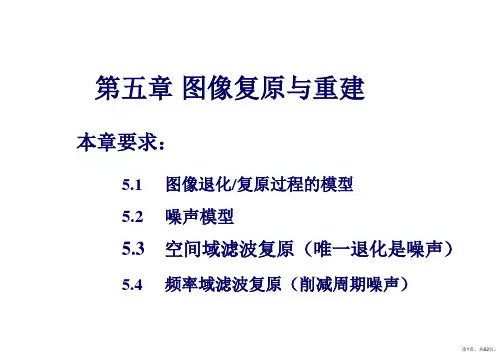
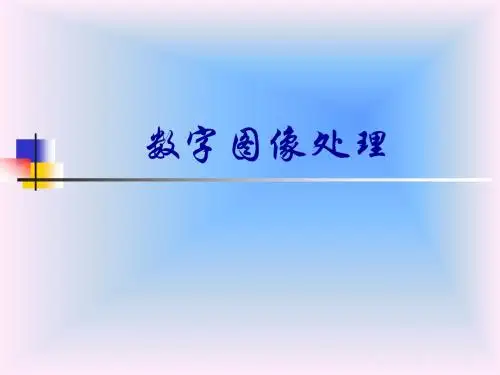
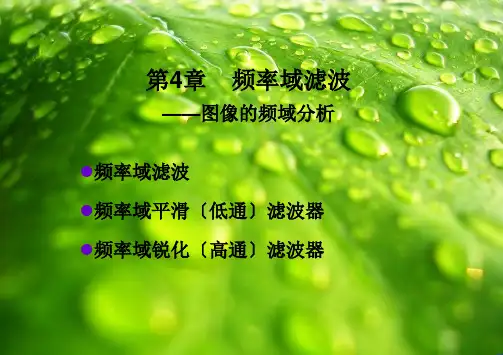
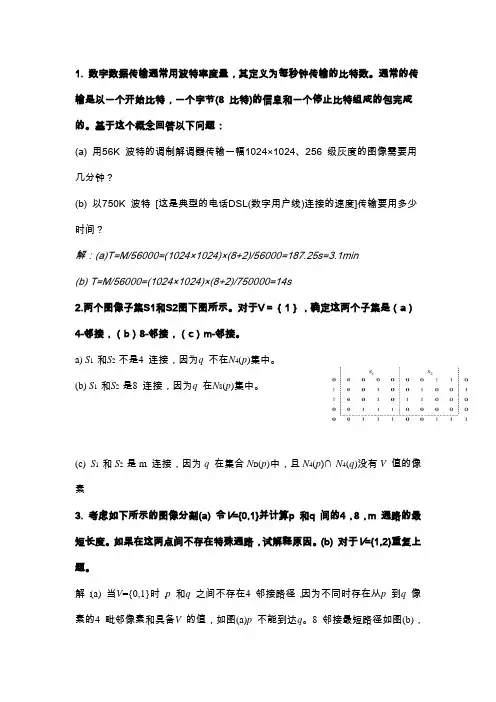
1. 数字数据传输通常用波特率度量,其定义为每秒钟传输的比特数。
通常的传输是以一个开始比特,一个字节(8 比特)的信息和一个停止比特组成的包完成的。
基于这个概念回答以下问题:(a) 用56K 波特的调制解调器传输一幅1024×1024、256 级灰度的图像需要用几分钟?(b) 以750K 波特[这是典型的电话DSL(数字用户线)连接的速度]传输要用多少时间?解:(a)T=M/56000=(1024×1024)×(8+2)/56000=187.25s=3.1min(b) T=M/56000=(1024×1024)×(8+2)/750000=14s2.两个图像子集S1和S2图下图所示。
对于V={1},确定这两个子集是(a)4-邻接,(b)8-邻接,(c)m-邻接。
a) S1 和S2 不是4 连接,因为q 不在N4(p)集中。
(b) S1 和S2 是8 连接,因为q 在N8(p)集中。
(c) S1 和S2 是m 连接,因为q 在集合N D(p)中,且N4(p)∩ N4(q)没有V 值的像素3. 考虑如下所示的图像分割(a) 令V={0,1}并计算p 和q 间的4,8,m 通路的最短长度。
如果在这两点间不存在特殊通路,试解释原因。
(b) 对于V={1,2}重复上题。
解:(a) 当V={0,1}时,p 和q 之间不存在4 邻接路径,因为不同时存在从p 到q 像素的4 毗邻像素和具备V 的值,如图(a)p 不能到达q。
8 邻接最短路径如图(b),最短长度为4。
m邻接路径如图(b)虚线箭头所示,最短长度为5。
这两种最短长度路径在此例中均具有唯一性。
(b) 当V={1, 2}时,最短的4 邻接通路的一种情况如图(c)所示,其长度为6,另一种情况,其长度也为6;8 邻接通路的一种情况如图(d)实线箭头所示,其最短长度为4;m 邻接通路的一种情况如图(d)虚线箭头所示,其最短长度为6.或解: (1) 在V={0,1}时,p和q之间通路的D4距离为∞,D8距离为4,Dm距离为5。
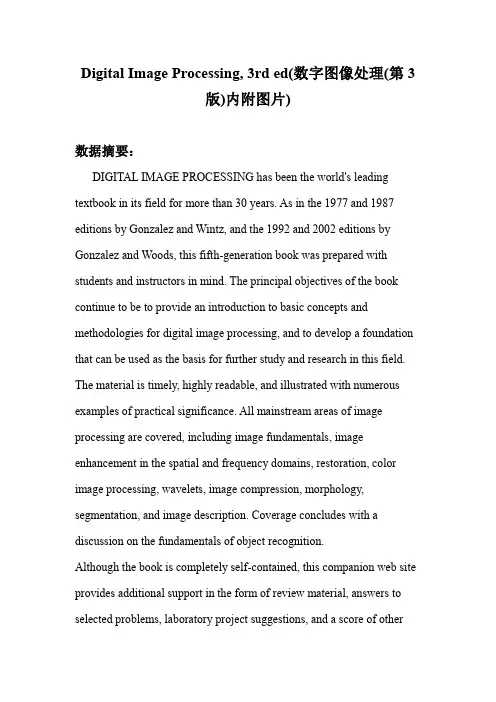
Digital Image Processing, 3rd ed(数字图像处理(第3版)内附图片)数据摘要:DIGITAL IMAGE PROCESSING has been the world's leading textbook in its field for more than 30 years. As in the 1977 and 1987 editions by Gonzalez and Wintz, and the 1992 and 2002 editions by Gonzalez and Woods, this fifth-generation book was prepared with students and instructors in mind. The principal objectives of the book continue to be to provide an introduction to basic concepts and methodologies for digital image processing, and to develop a foundation that can be used as the basis for further study and research in this field. The material is timely, highly readable, and illustrated with numerous examples of practical significance. All mainstream areas of image processing are covered, including image fundamentals, image enhancement in the spatial and frequency domains, restoration, color image processing, wavelets, image compression, morphology, segmentation, and image description. Coverage concludes with a discussion on the fundamentals of object recognition.Although the book is completely self-contained, this companion web site provides additional support in the form of review material, answers to selected problems, laboratory project suggestions, and a score of otherfeatures. A supplementary instructor's manual is available to instructors who have adopted the book for classroom use. See also a partial list of institutions that use the book.One of the principal reasons this book has been the world leader in its field for more than 30 years is the level of attention we pay to the changing educational needs of our readers. The present edition is based on the most extensive survey we have ever conducted. The survey involved faculty, students, and independent readers of the book in 134 institutions from 32 countries. Many of the following new features are based on the results of that survey.中文关键词:数字图像处理,图像基础,图像在空间和频率域的增强,图像压缩,图像描述,英文关键词:digital image processing,image fundamentals,image compression,image description,数据格式:IMAGE数据用途:数字图像处理数据详细介绍:Digital Image Processing, 3rd editionBasic Information:ISBN number 9780131687288.Publisher: Prentice Hall12 chapters.954 pages.© 2008.DIGITAL IMAGE PROCESSING has been the world's leading textbook in its field for more than 30 years. As in the 1977 and 1987 editions by Gonzalez and Wintz, and the 1992 and 2002 editions by Gonzalez and Woods, this fifth-generation book was prepared with students and instructors in mind. The principal objectives of the book continue to be to provide an introduction to basic concepts and methodologies for digital image processing, and to develop a foundation that can be used as the basis for further study and research in this field. The material is timely, highly readable, and illustrated with numerous examples of practical significance. All mainstream areas of image processing are covered, including image fundamentals, imageenhancement in the spatial and frequency domains, restoration, color image processing, wavelets, image compression, morphology, segmentation, and image description. Coverage concludes with a discussion on the fundamentals of object recognition.Although the book is completely self-contained, this companion web site provides additional support in the form of review material, answers to selected problems, laboratory project suggestions, and a score of other features. A supplementary instructor's manual is available to instructors who have adopted the book for classroom use. See also a partial list of institutions that use the book.One of the principal reasons this book has been the world leader in its field for more than 30 years is the level of attention we pay to the changing educational needs of our readers. The present edition is based on the most extensive survey we have ever conducted. The survey involved faculty, students, and independent readers of the book in 134 institutions from 32 countries. Many of the following new features are based on the results of that survey.NEW FEATURESA revision of introductory concepts that provides readers with foundation material much earlier in the book than before.A revised and updated discussion of intensity transformation, spatialcorrelation, convolution, and their application to spatial filtering.New discussion of fuzzy sets and their application to image processing.A new chapter on the discrete Fourier transform and frequency domain processing.New coverage of computerized tomography.A revision of the wavelets chapter.A new chapter on data compression, including new compression techniques, digital video compression, standards, and watermarking.New coverage of morphological reconstruction, gray-scale morphology, and advanced morphological algorithms.New coverage of the Marr-Hildreth and Canny edge detection algorithms.Expanded coverage of image thresholding.New examples and illustrations involving over 400 new images and more than 200 new drawings and tables.Expanded homework sets, including over 80 new problems.Updated bibliography.Differences Between the DIP and DIPUM BooksDigital Image Processing is a book on fundamentals.Digital Image Processing Using MATLAB is a book on the software implementation of those fundamentals.The key difference between the books is that Digital Image Processing (DIP) deals primarily with the theoretical foundation of digital image processing, while Digital Image Processing Using MATLAB (DIPUM) is a book whose main focus is the use of MATLAB for image processing. The DIPUM book covers essentially the same topics as DIP, but the theoretical treatment is not as detailed. Some instructors prefer to fill in the theoretical details in class in favor of having available a book with a strong emphasis on implementation.© 2008 by Pearson Education, Inc.Pearson Prentice HallPearson Education, Inc.Upper Saddle River, New Jersey 07458All rights reserved. No part of this book may be reproduced, in any form, or by any means, without permission in writing from the publisher. Pearson Prentice Hall ® is a trademark of Pearson Education, Inc. The authors and publisher of this book have used their best efforts in preparing this book.These efforts include the development, research, and testing of the theories and programs to determine their effectiveness.The authors and publisher make no warranty of any kind, expressed or implied,with regard to these programs or the documentation contained in this book.The authors and publisher shall not be liable in any event for incidental or consequential damages with, or arising outof, the furnishing, performance, or use of these programs. 数据预览:点此下载完整数据集。

